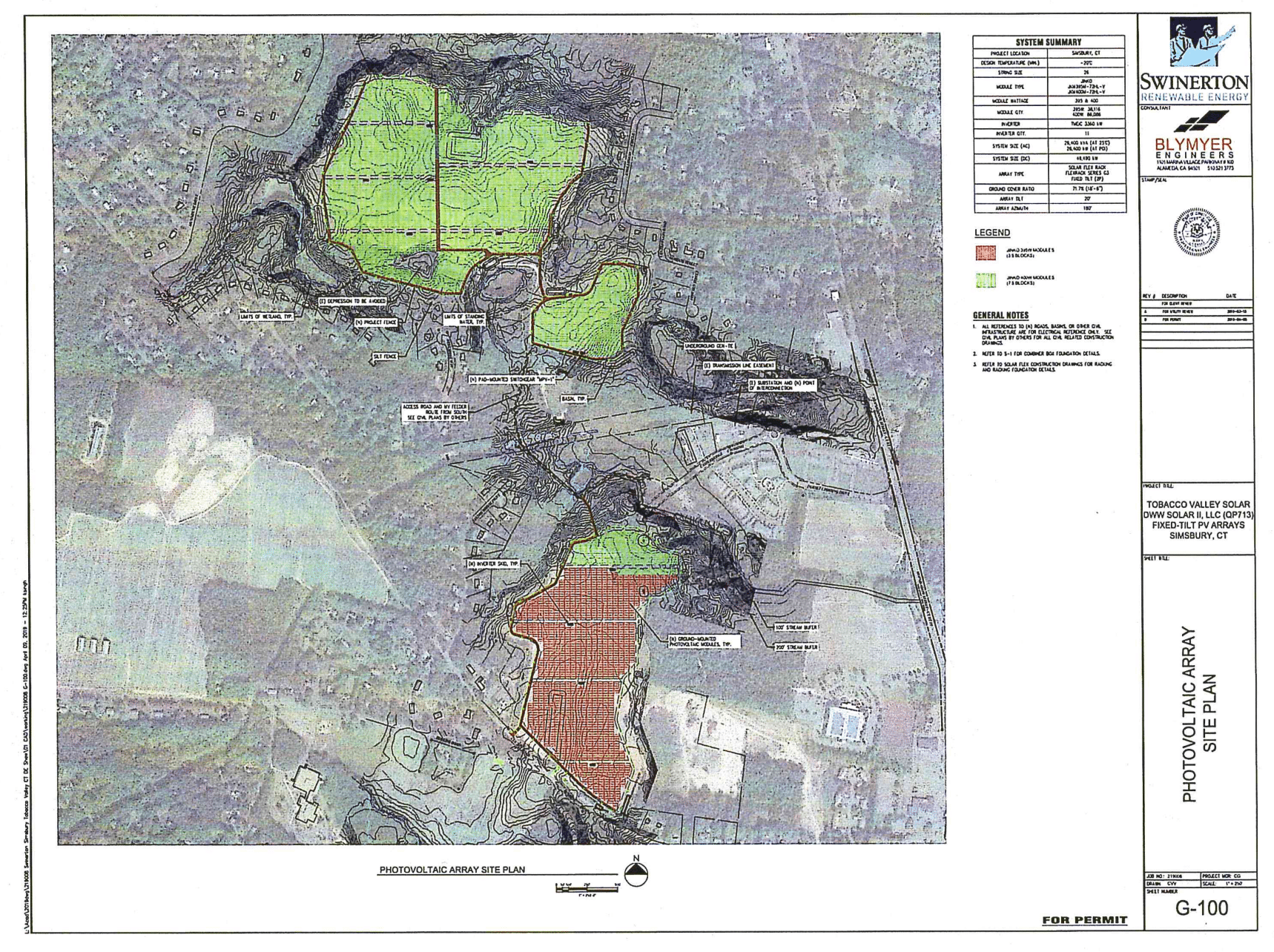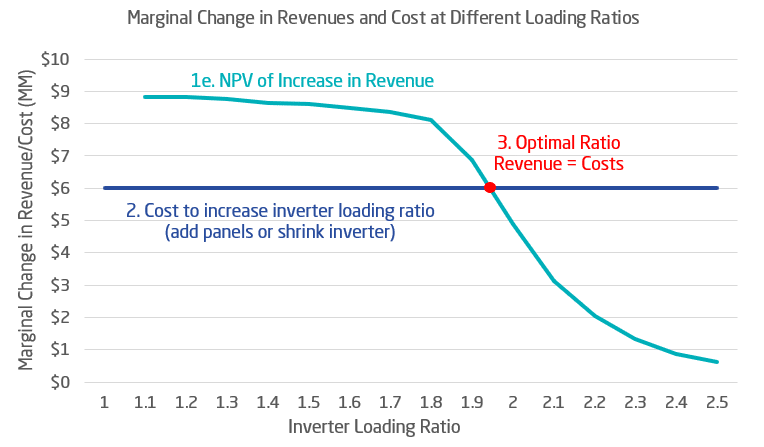Historically, we’d been taught that solar modules were the most precious of goods – to be held closely, to be loved. There’s that famous graph showing the price per watt falling from $100 in the 1970s, to the less than 30¢/watt these days. Now, we still care greatly about our solar modules – however – we use them differently as the facade of ideology falls in the face of modern knowledge.
Solar FlexRack has announced that Swinerton Renewables has contracted its GX-3 fixed racking system for a 26.4 MWac solar power system located in Simsbury, Connecticut. The Tobacco Valley Solar Project was developed by Deepwater Wind, who signed a long term power purchase agreement (PPA) with Eversource of Massachusetts. The PPA suggested that the solar power plant would receive payments for both the electricity and value of capacity (like all major utility scale solar plants are paid these days).
The most interesting part of the design in the DC:AC ratio though – a very rough public filing at the end of May (see page 19 pdf) – suggests over 48.6 MWdc of solar power, versus the publicly announced 26.4 MWac.

The blurry public document shows a portion of the project will be greater than 84,000 400-watt solar modules, plus 38,000 395-watt modules manufactured by Jinko, though the model number couldn’t be found. These numbers total 33.6 MWdc of 400-watt, and 15 MWdc of 395-watt modules – totalling 48.6 MWdc. No mention of energy storage could be found in any designs.
The system is projected to generate enough electricity to power 6,800 homes in the United States over the course of a year. The average home uses 10,000 to 12,000 kWh/year – suggesting 68 to 81 GWh/year. This would compute to an AC capacity factor of 29% to 35% on a non-tracking solar power system in Connecticut – far to the north of the range where even tracking systems are dominant. The DC capacity factor is a much more sensible 16-19% value. A 1/10 sized rough production analysis in Helioscope (pdf) shows 11% of the electricity would be clipped, and total generation delivered to the grid would be 60 GWh – which suggests Swinerton Renewables (one of the nation’s leading builders of solar power) is able to optimize greatly their designs.
The last time the EIA reported on this (looking at data through the end of 2016), they showed that utility scale systems have slowly increased their DC:AC ratios to around 1.25:1.

That 2016 data also included a few plants built by NextEra/FPL that had very high DC:AC ratios. The Babcock Solar Farm, noted as the the nation’s current largest operational solar + storage power plant – with a 10MW/40MWh energy storage system – has a 126MWdc/74.5MWac solar power system. This is a 1.7:1 DC to AC ratio, but this plant has energy storage.
The Babcock plant was built in 2016, and it was probably designed a couple of years earlier. So that could mean that NextEra has deployed this model elsewhere, maybe several times more.
Consider that 8minute Solar Energy has modeled solar + storage with extreme DC:AC ratios like 3-4-5:1 that are coupled with massive amounts of storage, allowing for 24:7 solar power plants that they hope to deploy within five years. This is the company with the nation’s lowest priced power contract right now, and this author suggests that 8minute is making use of this technique to get that price.
Of course, not all solar power systems want a high DC:AC ratio – some want it flat. Ideal Energy of Iowa built a single axis tracker, with flow batteries, designed for peak shaving. The DC:AC ratio, approaching a 1:1 value, is because the facility is not allowed to export excess electricity per the interconnection agreement. The developer noted that getting rid of the export means the interconnection application was faster and cheaper.
Scream out loud “use case” from the rooftop.

Last year, Fluence Energy gave guidance on optimizing solar module loading ratios, suggesting that a 1.9:1 DC:AC solar panel to inverter ratio, in defined circumstances, makes economic sense with integrated DC-coupled energy storage. Fluence estimates 60¢ per watt for that extra hardware.
Research in Minnesota has shown that oversizing the DC:AC ratio for wintertime production will offset the need for long term storage (in sunny Minnesota). NREL and FirstSolar developed models showing how oversizing solar allows for predictable use of the excess power produced for ancillary services. In another use case, FirstSolar and the Tampa Electric Company, showed that oversizing and designing flexibility with that oversizing allows for more solar power to be installed, and greater amounts of solar electricity to be delivered to the grid.
The purpose of this article is to illustrate that it is time for us to let loose of the standard values we usually consider for DC:AC ratio when designing our solar power systems. Sometimes it makes sense to build on north facing roofs, sometimes the panels are flat, sometimes you have energy storage, or – like in Connecticut – you have an opportunity to make revenue from other streams than simply electricity generation, and extra solar modules are now a financially viable means to do that.
This content is protected by copyright and may not be reused. If you want to cooperate with us and would like to reuse some of our content, please contact: editors@pv-magazine.com.








If I had a DC coupled battery, I would “over” build the panels too.
No batteries reported
Who ever published the “Public documents” in the headline is basically saying that the efficiency of the inverters would have to be close to 55%.
What am I missing here?
???
Not at all.
DC: the panels and battery
AC: the inverter
My ‘best’ guess is the determination of MWac and MWdc. Remember that electronic switching technology like radio frequency generators has a power in to power out ratio which is determined by the ‘load’. Realistically one should be able to get from 90% to 98% efficiency from an inverter depending on the load, in this case the grid. All in all, the grid is still an inefficient distribution system. You have to step up the voltage to get the generated product onto the grid at an average 3% per voltage step. Then when the generated power gets into a community, the power has to be stepped down from say 100KV to 50KV to 12.8KV to 7.5KV, maybe once more to the residential 240VAC we use in our homes. It would save a lot of energy if one could site these plants on the edge of town, step them up to the 50KV or even 12.8KV point before stepping them down for home use. Just proves that solar PV is the most efficient when installed on the roof of the home or business that will use the power.
Thanks for your explanation. Yet once the the 48.6 MW DC is converted to AC at 90-98% and introduced to the grid, is it not on the same level playing field as the AC delivered by the 26.4 MW AC system? BTW, I also missed how you can get a PV panel to put out anything but DC without an inverter.
The inverter(s) are limited to ~ 26.4 MW.
The plan (presumably) is to divert any power being produced over 26.4 MW to the battery for use when the sun is not shining (or shining less.)
As I posted earlier, this article has nothing to do with the DC:AC ratio as we normally use it and everything to do with having a battery that can take DC directly from the PV output.
No batteries
@John Weaver,
Then it says a lot about the CT solar resource
That’s absolutely part of it. In the article I did a helioscope that suggested 11% clipping, but it doesn’t line up with the projections from the press release which suggests a lot less clipping. Maybe panels are angled east and west a bit?
That would make a lot of sense. Oddly enough I was playing around with E/W orientations in a spreadsheet this week and was partial to 3:1 W:E system for New Mexico.
At least in my corner of the world, that sort of system inclined at 45 degrees extends 25% of STC production out another 90 – 120 minutes in the evening during the summer. As an aside, along with better building envelopes this would take care of a fair fraction of the evening peak utilities are struggling with.
E-W orientation may make sense to better match up with local demand, which is usually higher in morning and late afternoon. By having 40% of panels face to the east, with the rest to the west, they may be able to better match the load profile of the local customers.
@DougB,
Pretty much although the metric of merit for utilities is marginal cost. Load is related. Evening load may be lower than during the daytime but the peak often requires use of expensive NG peaker plants. This is the market that E-W orientations are playing in.
My thought is that when it comes to systems of these sizes, orientation should be optimal. Why in fact place a farm where it can’t fully produce?